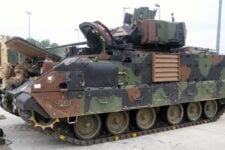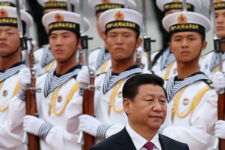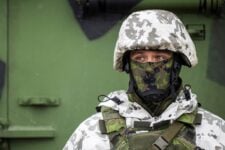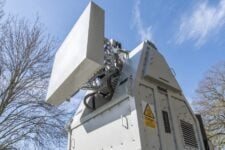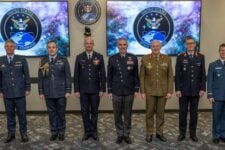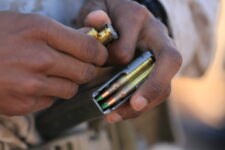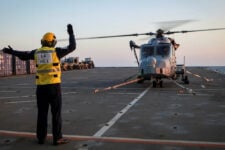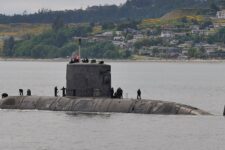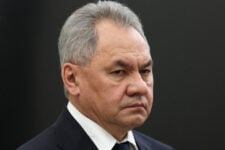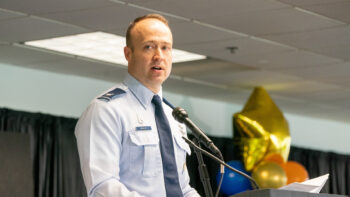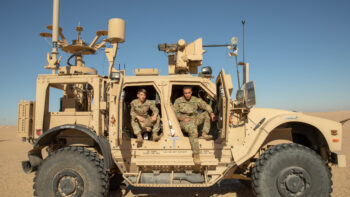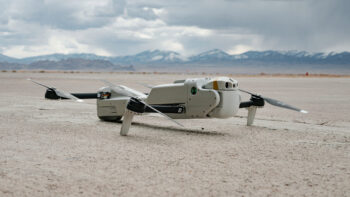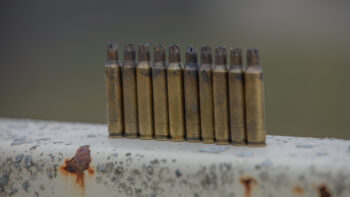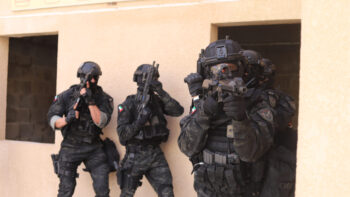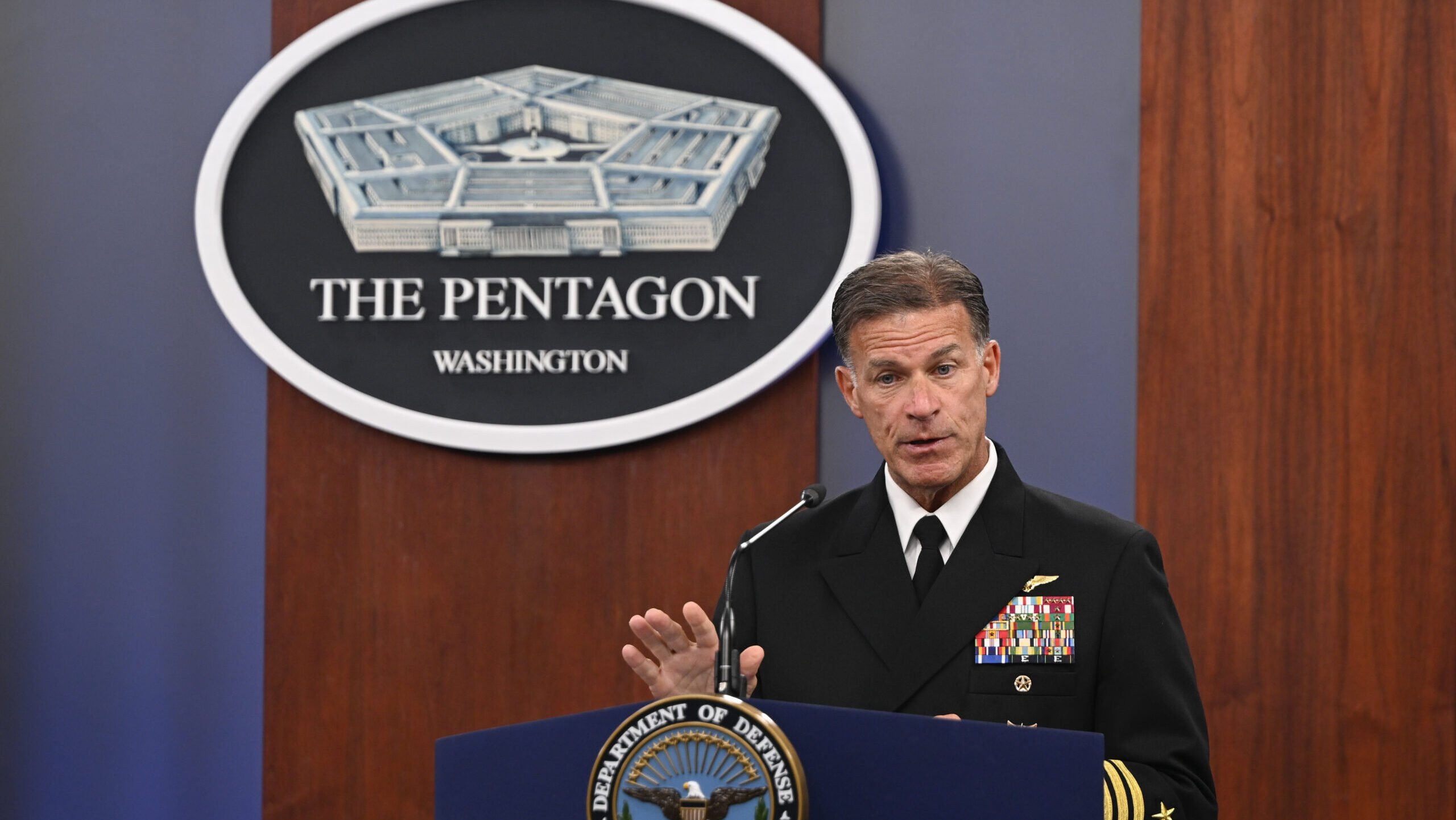
Navy Adm. John C. Aquilino, commander, U.S. Indo-Pacific Command holds a press conference at Pentagon in Washington D.C., United States on October 17, 2023. (Photo by Celal Gunes/Anadolu via Getty Images)
In recent years, the Pentagon has been pursuing the dream of Combined Joint All-Domain Command and Control (CJADC2), but still seems years away from achieving it — even though the conflicts it is designed for could break out at any moment. In this new op-ed, retired Army officer John D. Rosenberger says the best way to get CJADC2 over the finish line may be to let America’s Pacific commander take charge.
If Beijing wants to execute a first strike and seize Taiwan, the ideal time might be right now, with the Pentagon’s internal posture and communications links nowhere prepared to respond.
At the moment, Indo-Pacific Command (INDOPACOM) has no Standing Combined Joint Task Force (SCJTF) trained, poised, and ready to immediately employ the combat power of its Component Commands to defeat the PLA’s effort. Adm. John Aquillino, the outgoing INDOPACOM chief, would have to form an ad hoc operational CJTF that would take weeks to assemble and prepare for combat. And if he did establish a SCJTF, Aquillino has no functional and resilient Combined Joint All-Domain Command and Control (CJADC2) network enabling a CJTF commander to exercise effective command and control of all his forces, one that could function reliably under relentless electronic warfare, kinetic attacks, and cyberattacks by the PLA.
In other words, a SCJTF commander has no means of conducting synchronized Joint All Domain Operations, and to defend Taiwan. That needs to change, and change rapidly. The best solution: giving INDOPACOM the money and authorities to lead development of CJADC2 across the Pentagon and drive it with an operator’s real-world viewpoint.
The CJADC2 problem is well covered by now, but it’s worth revisiting briefly. DoD’s communication networks and mission command systems exist as stove pipes within each service, uniquely developed by different defense contractors to meet specific requirements for each service over several decades. None were ever designed or compelled to interact seamlessly with communication networks from other services.
Absent a CJADC2 network, a CJTF commander, and his subordinate Component Commanders cannot develop and sustain a Joint Common Operating picture to gain and maintain common situational awareness of the location, combat status, and activities of all Combined/Joint forces, as well as PLA forces, within the air, land, maritime, space, and cyber domains. Consequently, Component Commanders and their subordinate formations will view the situation differently from their vantage point and act accordingly, leading inevitably to redundant targeting, waste of munitions, incoherent piecemeal attacks by the separate Component Commands, and fratricide. Not the situation you want when operating in a volatile environment like a Taiwan situation would be.
Given the complexity of system, forming a single, functional, and resilient CJADC2 network is near impossible, and DoD’s top down approach to creating one the past few years has been an abject failure at enormous expense of taxpayer dollars. More promising are recent efforts to create a CJADC2 network from the bottom up. That was successfully executed by DoD’s Global Information Dominance Experiment (GIDE) and the Army’s Project Convergence experiments which have created a promising short-term, functional CJADC2 network to support a series of live, small-scale, Combined Joint experiments. For example, in Project Convergence Capstone 4, enabled by a functional CJADC2 network, Combined/Joint kill chains were reduced from minutes to seconds.
However, it took over a year and a half to integrate service and multinational communication systems to achieve the requisite data flow between a collection of Joint and Multinational platforms and mission command systems. Service-specific mission command software and message formats were incompatible and had to be re-engineered and patched together to share data across the Combined Joint warfighting team. Software bridges had to be developed to enable communication between Services. And what happened after achieving this unprecedented success? The network server stacks were disassembled with DoD having no plan but years of further experimentation to cobble something together.
Along those lines, Aquilino has tried to create his own local network. In his testimony before Congress in March 2024 he described his critical need for a functional, resilient CJADC2 network and his struggle to create a prototype, which he calls a “Joint Fires Network,” in house, as a means to integrate, synchronize, and apply the combat power of his Component Commands. As he testified, “The approach we’ve taken with the Joint Fires Network is to pull together a best-of-breed approach of Project Convergence from the Army, Project Overmatch from the Navy and Marine Corps, and then the Advanced Battle Management System from the Air Force, along with the DARPA aspect of Assault Breaker II—pull all those together and deliver a near-real-time, best-of-breed solution to be able to command and control the joint force and ultimately close the kill chain.” Aquilino went on to testify that this effort to cobble a functional CJADC2 prototype network together required $213 million, but $122 million of this was not funded in the Pentagon’s budget. As a result, a CJTF Commander fighting within INDOPACOM’s AOR will go to war today and in the years ahead without a functional, resilient CJADC2 network that meets his needs and the needs of his subordinate Component Commands.
Enough. It’s time for a new approach, one that prioritizes where the US needs this capability the most. Stop the current efforts of DoD and the individual Services to create a CJADC2 network in disjointed fashion, reprogram the funds currently earmarked for this effort and give the mission of creating a CJADC2 network to the INDOPACOM commander.
Empower him to get it done and place the Service Chiefs in support. No one has a more vested interest. Provide the CINC a project team composed of experts from all Services, Functional Commands, and Allied partners, led by an experienced Joint warrior who knows his business and knows what a CJTF Commander in INDOPACOM needs. Give him all the resources and authority he needs to bring the network to life within two years — a realistic goal, based on what we’ve seen from Convergence and GIDE.
To accelerate the network’s development, fully fund INDOPACOM’s annual exercise program, enabling the CINC and his project team to conduct a campaign of experimentation, embedded within the exercise program. Better yet, form a stable SCJTF for experimentation to iteratively develop a functional, resilient CJADC2 network — exercise by exercise — identifying problems, developing solutions between iterations, and steadily reducing network vulnerabilities.
Many people in the Pentagon won’t be thrilled with this idea, but they would be less thrilled about being called before Congress to explain why the Chinese Communist flag flies over the capital of Taiwan, Japan, the Philippines, or any other ally in the region. The clock is ticking, and bold moves are needed. Let us waste no more time.
Colonel (Ret) John D. Rosenberger served 29 years in the U.S. Army as an armored cavalry officer and 20 years as a defense contractor at the forefront of Army and Joint modernization. For two years, serving directly for the SACEUR, he orchestrated the training of all NATO Combined Joint Task Forces in Europe in planning and executing large scale conventional operations. The views expressed are those of the author and do not reflect the official position of JANUS Research Group, Department of the Army, or the Department of Defense.
